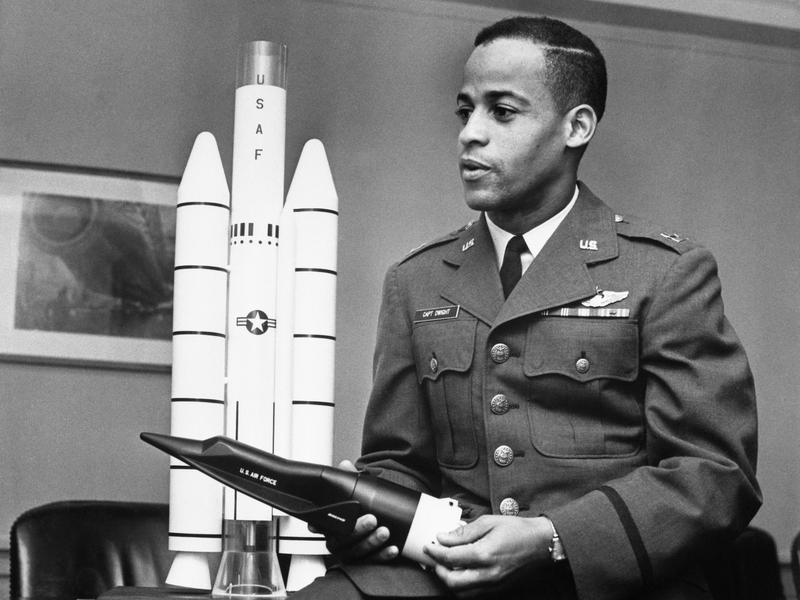 All Things Considered
All Things Considered
'Black In Space' Explores NASA's Small Steps And Giant Leaps Toward Equality

For many Americans, the first moon landing remains the most memorable moment in the history of manned space travel.
It was a high-water mark in the space race, but as the United States and Soviet Union were rushing to prove their dominance, a lesser known chapter in that battle was taking place: America's effort to send a black man into space.
Black in Space: Breaking the Color Barrier, a new documentary on the Smithsonian Channel, brings light to the groundbreaking moment that almost came to be during the heights of the civil rights movement.
The film centers on the story of Ed Dwight, who in the early 1960s was on his way to becoming the first African American astronaut. In 1962, the Kennedy administration named Dwight, an Air Force pilot at the time, as the first African American astronaut trainee.
The selection was made after an emphatic pitch from broadcast journalist Edward R. Murrow. President John F. Kennedy tasked Murrow, appointed as the head of the United States Information Agency, with strengthening the country's image abroad.
As the civil rights movement was gaining ground, the U.S. was still largely segregated. But Murrow's proposal to NASA to put the first man of color in space was his diplomatic appeal to the majority "non-white world," as The New York Times noted:
"Why don't we put the first non-white man in space?" Murrow wrote to NASA's administrator. "If your boys were to enroll and train a qualified Negro and then fly him in whatever vehicle is available, we could retell our whole space effort to the whole non-white world, which is most of it."
In his 2009 memoir, Soaring on the Wings of a Dream, Dwight details his experiences with discrimination from classmates and superiors during the astronaut training program.
When President John F. Kennedy was assassinated in November 1963, Dwight lost his most important ally, and his dreams to reach space came to an end. He was soon reassigned from astronaut training to unrelated Air Force projects.
"It really is disappointing that he did not fly and was not a part of the Apollo experience," Robert Satcher, a black astronaut who went to space in 2009, tells NPR's All Things Considered. "It would've been fantastic if we saw Ed Dwight walking on the moon."
For years, Dwight's story was largely forgotten. Satcher himself says he didn't know about that chapter of NASA's history until he worked there.
"Although there's a lot to be proud of at NASA, I think it's one of those chapters that is consistent with a lot of other disappointments that African Americans have experienced in this country," he says.
It wasn't until 1983 that Guion Bluford Jr. would become the first African American to travel in space. And nearly three decades after Neil Armstrong and Buzz Aldrin landed on the moon, a black astronaut, Bernard Anthony Harris Jr., was the first African American to perform a spacewalk in 1995.
Satcher says NASA's early struggles to integrate its force has put American scientific discovery behind.
"If we're gonna be at our best in bringing all the best minds to bear on this incredibly difficult problem, which is deep space exploration, then everybody needs to be included," he says.
"You never know where the next Einstein, genius, whoever, is gonna come from. Maybe we haven't discovered some discovery that we could've made because of denying some kid an opportunity just because of how they look."
Satcher says the pioneering work of astronauts like Bluford and Harris is what inspired him to believe he too could join the ranks of African Americans who made it to space. In 2009, he got that opportunity when he took off on a construction mission aboard the now-retired space shuttle Atlantis.
As part of his work, he repaired a robotic arm operated by another black astronaut, Leland Melvin.
"When I first applied, I had an idea that I could get in because there were other African American astronauts that I saw, and actually got to meet," he says. "We need to have everybody represented so that kid, wherever he is or she is, can look there and say yeah, you know, 'I can do that too.' "
NPR's Andrew Craig and William Troop produced and edited this interview for broadcast. Emma Bowman produced the Web version.
9(MDEwODYxNTQyMDEzNjAxODk2Nzc2NzNmYQ001))